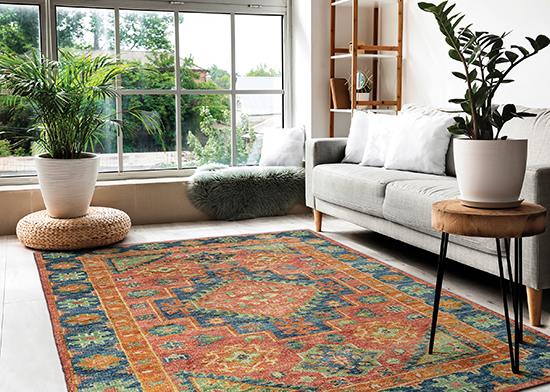Area Rugs-Producer Highlights: Rug producers are struggling to keep up with surging demand - April 2021
By Darius Helm
Area rugs are in many ways the ideal floorcovering for today’s market. First of all, they’re affordable. These days, you can get a rug for the price of a couple of lamps. That affordability, combined with how they go atop finished floors and can be moved around, has made them more of an accessory than the foundation of the room, unlike with all other floorcoverings. And that means that people change them out more frequently, so repeat business moves through a faster cycle.
The average price paid by the consumer for rugs has been falling for the last couple of decades. On the supply side, this is because of advanced machinery and fiber developments that enables the creation of great looking products at a low price and because more of the products are imported from countries with cheaper labor. On the demand side, there’s the Internet, which drives the market, in this case driving it down.
In addition, there are logistical advantages, and unlike other floorcoverings, rugs are easily shipped (and returned). When it comes to channels, the Internet accounts for just over 30% of area rug sales, followed by furniture stores at 25%, mass merchants at 17%, home improvement centers at 15%, floorcovering retailers at 8% and rug specialists at just 4%. (During the peak Covid months last year, March through August, the Internet’s share of sales surged to over 40%.)
The higher end rugs-the handmade goods, the wool and silk imports-are mostly sold through rug specialty retailers and furniture stores, which are shrinking channels, while the entry-level products are clustered in growth channels like the Internet, mass merchants and home centers, which combine to account for close to two thirds of the whole rug market.
The bulk of what is sold in the U.S. market is imported, mostly from Turkey, India, China and Egypt-in Egypt’s case it’s mostly Oriental Weavers, but in the other importing nations there are hundreds of smaller producers supplying the U.S. market.
However, consumers don’t seem to make purchases based on country of origin; a recent Houzz survey showed that 71% of those buying area rugs had no idea about the origin of their rugs.
In area rug purchases, the consumers’ top priority is the look-the color and design and how it meets their specific needs-and after that they’ll look at price. So they tend not to shop by brand and nor are they comparing prices. That’s particularly true when shopping online, where a single website has thousands of offerings, across all brands and price points.
Currently, the rug market is facing a range of headwinds that are both slowing the movement of product and adding huge price pressures, but these dynamics are most likely short term. Raw materials are in short supply, petrochemical prices are rising-polypropylene, for instance, has more than doubled in price, and it’s the same for jute-and container prices have more than doubled. The port congestion on the West Coast is now hitting East Coast ports (Savannah’s congestion is at a record level), so product is sitting out in the water for weeks on end, waiting for a dock. And there are barriers on land as well, including labor shortages and the increased costs of safety protocols.
Last year, the U.S. area rug market showed good growth, likely up by double digits. Next month’s Annual Report will break down all those industry statistics and also offer indepth reports on the top five domestic producers. In terms of product, area rug trends include painterly abstract looks, neutrals, textures and reinterpretations of classic designs in updated colorways, which are illustrated here by some of the leading player in the market.
Copyright 2021 Floor Focus
Related Topics:Coverings
